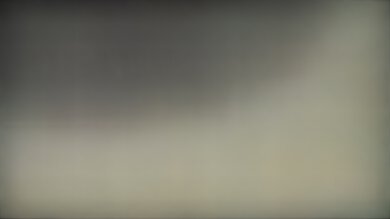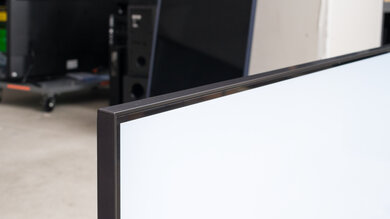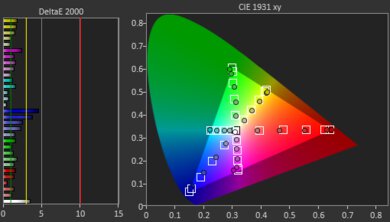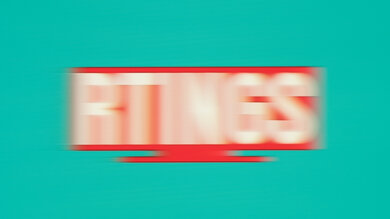The LG NANO90 2021 is a good overall 4k TV. It's at the top of LG's mid-range NanoCell lineup and is a slight improvement over the LG NANO90 2020. It's a good choice if you want to use it in a well-lit room because it gets bright enough to fight glare and has impressive reflection handling. Gamers will appreciate features like its 120Hz panel, HDMI 2.1 inputs, and variable refresh rate (VRR) support. It also has a quick response time and low input lag for gaming. It has an IPS panel with fairly wide viewing angles, but it's not as good as most IPS panels because the image starts to look darker when viewing from an angle. It also has low native contrast, so blacks look gray, and the local dimming feature crushes any bright highlights, so it doesn't improve the picture quality.
Our Verdict
The LG NANO90 2021 is good for most uses. It performs best for watching shows or sports because it has fairly wide viewing angles, impressive reflection handling, and good peak brightness. It's also good for gaming thanks to its HDMI 2.1 and VRR support, low input lag, and quick response time. Sadly, it's just okay for watching movies, both in SDR and HDR, because it has a low contrast ratio that makes blacks look gray, and the full-array local dimming feature fails to improve the picture quality.
- Gets bright enough to fight glare in most rooms.
- Impressive reflection handling.
- Quick response time results in smooth motion.
- 120Hz panel and VRR support.
- Low native contrast ratio.
- Local dimming performs poorly.
- Image looks darker at wide viewing angles.
The LG NANO90 2021 is very good for watching TV shows. It has impressive reflection handling and gets bright enough to fight glare, so visibility won't be an issue in most rooms. It doesn't have any trouble upscaling 720p content, like from cable boxes. It has fairly wide viewing angles, but you may notice the image looks darker if you sit at an angle.
- Gets bright enough to fight glare in most rooms.
- Impressive reflection handling.
- Image looks darker at wide viewing angles.
The LG NANO90 2021 is very good for watching sports. Fast-moving content looks good thanks to its 120Hz panel and quick response time. It's a great choice for use in well-lit rooms because it gets bright enough to fight glare and has impressive reflection handling. It has fairly wide viewing angles if you want to watch the big game with a few friends, but it's not suggested if you're going to watch it from wide angles.
- Gets bright enough to fight glare in most rooms.
- Impressive reflection handling.
- Quick response time results in smooth motion.
- Image looks darker at wide viewing angles.
The LG NANO90 2021 is good for gaming. It has gaming features most people are looking for like a 120Hz panel, VRR support, and HDMI 2.1 inputs. It has a quick response time for smooth motion, and the input lag is low. Sadly, it's not a good choice for dark room gaming because it has a low contrast ratio and the local dimming feature performs poorly, so blacks look closer to gray.
- Quick response time results in smooth motion.
- 120Hz panel and VRR support.
- Low input lag.
- Low native contrast ratio.
- Local dimming performs poorly.
The LG NANO90 2021 is okay for watching HDR movies. Its IPS panel has a low native contrast ratio, so blacks look gray, and the local dimming feature crushes highlights. There's also considerable blooming around bright highlights in dark scenes. The HDR brightness isn't anything special, so content doesn't pop how it should.
- Decent HDR brightness.
- Removes 24p judder from any source.
- Low native contrast ratio.
- Local dimming performs poorly.
The LG NANO90 2021 is good for HDR gaming. It has good gaming features like VRR support and a 120Hz refresh rate. It offers a responsive gaming experience due to its quick response time and low input lag. However, HDR content doesn't look good because it has a mediocre contrast ratio, poor local dimming, and low HDR brightness.
- Quick response time results in smooth motion.
- 120Hz panel and VRR support.
- Low input lag.
- Low native contrast ratio.
- Local dimming performs poorly.
The LG NANO90 2021 is excellent to use as a PC monitor. It has fairly wide viewing angles, so the image remains somewhat accurate at the edges if you sit up close. It has low input lag, and it displays proper chroma 4:4:4, which is important for reading clear text when using it as a monitor. Visibility won't be an issue in most well-lit rooms because it has impressive reflection handling and good peak brightness.
- Gets bright enough to fight glare in most rooms.
- Impressive reflection handling.
- Quick response time results in smooth motion.
- Low input lag.
- Image looks darker at wide viewing angles.
Changelog
- Updated Jul 08, 2025: We uploaded the latest brightness measurements and uniformity photos for the Accelerated Longevity Test.
- Updated Apr 17, 2025: We uploaded the latest brightness measurements and uniformity photos for the Accelerated Longevity Test.
- Updated Feb 11, 2025: We uploaded the latest brightness measurements and uniformity photos for the Accelerated Longevity Test.
- Updated Nov 20, 2024: We uploaded the latest brightness measurements and uniformity photos for the Accelerated Longevity Test.
Check Price
Differences Between Sizes And Variants
We tested the 55 inch LG NANO90 2021 (55NANO90), and for the most part, we expect our results to be valid for the 65 inch (65NANO90), 75 inch (75NANO90), and 86 inch (86NANO90) variants as well. Keep in mind that the LG NANO90 2020 uses similar model codes, but the one way to differentiate between the two is that the 2020 model ends in UNA while the 2021 model has UPA. In Europe, it's sold as the LG NANO91 and has a center-mounted stand instead, but we expect it to perform the same.
| Size | North America | Europe |
| 55" | 55NANO90UPA | 55NANO916PA |
| 65" | 65NANO90UPA | 65NANO916PA |
|
75" |
75NANO90UPA | 75NANO916PA |
| 86" | 86NANO90UPA | 86NANO91PA |
If someone comes across a different type of panel or if their LG NANO90 doesn't correspond to our review, let us know and we'll update the review. Note that some tests, like gray uniformity, may vary between individual units.
The unit we tested was manufactured in April 2021 and you can see the label here.
Popular TV Comparisons
The LG NANO90 2021 is a good overall 4k TV. It has gaming features most people will appreciate, like HDMI 2.1 and VRR support. However, it's not a good choice for dark room gaming, and there are better options available with improved contrast, like the Sony X90J. Even if you need wide viewing angles, something like the Samsung Q80/Q80A QLED has better local dimming with a similar panel type.
Also see our recommendations for the best LG TVs, the best 4k TVs, and the best TVs for watching movies.
The LG C1 OLED is much better than the LG NANO90 2021. The C1 has a near-infinite contrast ratio for perfect blacks, and there's no blooming around bright objects. The C1 also has wider viewing angles, which is great if you have a large seating area, and it has better gaming performance thanks to its nearly instantaneous response time.
The Samsung Q70A and the LG NANO90 2021 are both good TVs that use different panel types. The Samsung has a VA panel with a much better contrast ratio, and even though it doesn't have local dimming like the LG, it's still a better choice for use in dark rooms. The LG doesn't get as bright as the Samsung, but it has much better reflection handling. The LG has an IPS panel with wide viewing angles, so it's a better choice for wide seating arrangements. They're both very good for gaming as they each have a 120Hz panel and VRR support, but the LG is G-SYNC compatible, which the Samsung isn't.
The LG NANO90 2021 and the LG NANO99 8k 2021 are both good TVs. They have many of the same features and performance, but the big difference is that the NANO99 2021 has an 8k resolution, while the NANO90 2021 is a 4k TV. Local dimming looks better on the NANO99 2021, but it's still mediocre, and each TV has an IPS panel with a low contrast ratio. The NANO99 2021 also has much better out-of-the-box accuracy, but this may vary between units. The one advantage the NANO90 2021 has is that there's VRR support to reduce screen tearing, which the NANO99 2021 doesn't have.
The Sony X90J is much better than the LG NANO90 2021 for most people. The Sony has much better contrast and a better local dimming feature, so it looks much better in a dark room, and dark scenes look better overall. The Sony is also significantly more accurate out of the box. On the other hand, the LG has better reflection handling and a wider viewing angle, so if you have a wide seating arrangement with a lot of windows, it's slightly better.
Test Results

From the front, this TV looks similar to the LG NANO90 2020. It has thin bezels and similar feet to the 2020 model, but they're slightly redesigned. The back has a new look, similar to the higher-end LG NANO99 8k 2020, but it doesn't look as sleek.
The metal feet are less deep than those on the LG NANO90 2020, and they support the TV well.
Footprint of the 55" TV: 43.3" x 10.1".
The back panel is made of smooth metal and has a somewhat premium look. There's cable management through the feet and hooks on the TV, which helps keep your setup clean.
The LG NANO90 2021 has decent contrast overall. The native contrast is very low, but thankfully the local dimming feature is extremely effective at boosting contrast. Dark scenes look great overall, even when bright highlights are noticeable on-screen. There are a few downsides to this, though, as this TV shows significant blooming around bright highlights.
Unfortunately, zone transitions are distracting. As bright lights move across the screen, you can see the zones turning on and off. The algorithms can't keep up with fast-moving content, so the leading edge is darker than it should be, as it doesn't turn the backlight on quickly enough, and there's a trailing halo behind bright objects.
The HDR brightness is okay. It gets brighter than in SDR, and it's an improvement from the LG NANO90 2020, but it's still not enough to make highlights pop. It gets brightest when small-to-medium-sized highlights stay on the screen for a short period, but they quickly lose their brightness the longer they stay on the screen. Once again, small highlights are dimmer because of frame dimming. The EOTF doesn't follow the target perfectly, as most bright scenes are over-brightened.
We tested it in the 'Cinema' HDR Picture Mode with Panel Brightness and Contrast at their max, LED Local Dimming set to 'Medium', and Color Temperature on 'Warm 50' with all other image processing disabled.
We couldn't achieve a brighter EOTF plot, but if you want the highest luminosity possible at the cost of image accuracy, then use the 'Vivid' Picture Mode with LED Local Dimming on 'Medium' and everything else at their default settings. We measured 1309 cd/m² using these settings in the 10% window.
The HDR brightness in the 'Game Optimizer' mode is the same as outside of it. The minor differences in measurement are due to variance between testing runs, and you won't see any difference with your eyes.
On average, this TV tracks the PQ EOTF well, but there are a few noticeable issues. Near-blacks are raised a bit, and midtones are slightly crushed, especially in content mastered at 4,000 nits. The brightest highlights the TV can display are overblown, and there's a sharp cutoff at the max luminance, causing a loss of fine details.
The LG NANO90 has good SDR brightness, a nice improvement from the LG NANO90 2020, but it's not as bright as the LG QNED90. It gets bright enough with real content to fight glare in most rooms. Brightness varies just a bit between our different test windows, and small highlights are dimmer than the rest due to frame dimming.
We tested SDR brightness after calibration in the 'Expert (Dark space, night)' Picture Mode with Color Temperature set to 'Warm 50', LED Local Dimming to 'Medium', and Panel Brightness to its max.
If you want the brightest image possible and don't care about image accuracy, we reached 1047 cd/m² in the 10% window in the 'Vivid' Picture Mode.
The LG NANO90 has a good color gamut for HDR content. It has excellent coverage of the DCI P3 color space used in most HDR content. Due to the bad color accuracy, tone mapping is also off. This results in the image looking cooler than expected, but it still looks good overall.
The color volume is just okay. It struggles to display dark colors because of its low contrast but does a better job with brighter colors.
The out-of-the-box accuracy is terrible. Although this can vary between units, we noticed similar behavior on the LG C1 OLED. We measured it with different equipment and kept getting the same results. White balance and colors are way off; yellow colors look more white than the actual color white. Gamma is awful, and all scenes are too bright, especially brighter scenes. Color temperature is also on the cool side, giving the image a blue tint. Also note that we disabled LED Local Dimming for the measurements.
We also tried measuring the accuracy in the 'Filmmaker Mode' Picture Mode and got slightly better, but similar, results. However, we don't suggest using this because it disables some settings:
- White Balance dE: 6.84
- Color dE: 6.12
- Color Temperature: 7332K
- Gamma: 1.68
Accuracy after calibration is fantastic. Any remaining inaccuracies to the white balance and colors are nearly impossible to spot. Gamma follows the target almost perfectly, and the color temperature is closer to our 6500K target.
See our recommended settings here.
The LG NANO90 has okay gray uniformity. The edges of the screen are visibly darker all around, and there's dirty screen effect in the center, which could get distracting during sports. However, uniformity is improved in near-dark scenes. Keep in mind that uniformity can vary between units.
The LG NANO90 has okay viewing angles, but it's nothing special for an IPS panel. The image quickly starts to look darker as you move off-center, and it looks inaccurate at wide viewing angles. It'll be fine for watching stuff with a few people around, but probably not suggested for large viewing parties.
The LG NANO90 2021 has impressive reflection handling. It handles even intense light pretty well, and combined with its good peak brightness, glare won't be an issue in most settings. It looks like it has a different coating from the LG NANO90 2020 as light looks more purple when reflected off, similar to the LG C1 OLED.
This TV has good gradient handling overall. There's more noticeable banding in dark shades of red and bright shades of green, but everything else looks great.
Unfortunately, this TV has poor sharpness processing, so low-resolution and low-bitrate content doesn't look good. Edges aren't very sharp, fine details are lost, and text is blurry.
The optimal settings for a sharp 480p image with no over-sharpening are as follows:
- Adjusted Sharpness: 24
- Super Resolution: On
The LG NANO90 2021 uses a proper IPS panel but with a BGR sub-pixel layout. This doesn't affect the overall picture but may have an effect on the way text is displayed. Read about it here.
This TV uses Pulse Width Modulation (PWM) to dim its backlight. The flickering starts when the Panel Brightness is set to anything below its max, but the frequency is so high that you won't notice it. However, it flickers at 120Hz in the 'Game Optimizer' Picture Mode.
The LG NANO90 has a Black Frame Insertion feature to try to improve the appearance of motion. It works for both 60fps and 120fps content, but it can create some image duplication. Keep in mind that the BFI score is based on the frequency at which the TV can flicker and not the actual performance.
See here for the settings that control the BFI feature.
There's a motion interpolation feature for lower frame rate content, known as the 'Soap Opera Effect'. It can interpolate 60fps up to 120fps, and it can interpolate 30fps up to 60fps, but it can't do it up to 120fps, which explains the blurriness of the top photo. With real content, the motion interpolation feature doesn't look that good. There are a few artifacts and motion blur with anything that's moving. It even stops interpolating altogether during busy scenes.
See here for the settings that control the motion interpolation feature.
Despite the quick response time, lower frame rate content doesn't stutter that much. If it bothers you, you can try enabling the motion interpolation feature.
The LG NANO90 2021 can remove 24p judder from any source. For it to work, simply enable Cinema Screen.
The LG NANO90 has native FreeSync and HDMI Forum VRR support to reduce screen tearing. On our unit, we set the AMD FreeSync Premium to 'High' to get the full refresh rate range with FreeSync because setting it to 'Wide' limits it to 60Hz. Although it's not officially certified to be G-SYNC compatible, we found it works with our RTX 3080 graphics card, but it doesn't work with any 1000 Series card. Enabling the VRR setting also disabled the LED Local Dimming, TruMotion, Noise Reduction, and Smooth Gradation settings.
The LG NANO90 2021 has incredibly low input lag as long as it's in the 'Game Optimizer' Picture Mode. LG introduced a new Prevent Input Delay setting to their 2021 TVs, and setting it to 'Boost' reduces the input lag by about 3ms for 60Hz content compared to the LG NANO90 2020. However, it doesn't affect anything with 120Hz content. Sadly, enabling the motion interpolation feature in 'Game' mode greatly increases the input lag, so it's not suggested for gaming.
Update 11/24/2021: We double-checked to make sure that this TV could display 4k @ 120Hz signals properly. Unlike TVs from other brands, including the Sony X90J and the Hisense U8G, LG doesn't use the MediaTek chipset and has no issues displaying 4k @ 120Hz.
The LG NANO90 TV displays any common signal up to 4k @ 120Hz. It displays proper chroma 4:4:4 on any supported resolution, which is important for reading fine text when using it as a PC monitor. For it to work, set the icon for the input you're using to 'PC' in the Home Dashboard. For full-bandwidth signals, set HDMI Deep Color to '4k'.
The LG NANO90 2021 doesn't have any issues displaying content from either the PS5 or Xbox Series X. It has Auto Low Latency Mode that automatically switches the TV into 'Game' mode when a game from a compatible device is launched. For it to work, simply enable Game Optimizer in the General Settings page.
Since HDMI 3 is also the ARC input, you may only be left with one HDMI 2.1 input (HDMI 4) if you need to connect a receiver.
The LG NANO90 supports eARC, allowing you to pass high-quality, uncompressed audio to a compatible receiver over an HDMI connection. It supports Dolby Digital audio formats, but not DTS. For it to work, set the HDMI Input Audio to 'Bitstream' for the input you're using, Digital Sound Output to 'Auto', and enable HDMI e-ARC Support.
The LG NANO90 2021 has a decent frequency response. It has a well-balanced sound profile that makes dialogue sound good. In our testing, any frequency above 11KHz sounded awful, but most content won't reach this high pitch anyways. There's a decent amount of bass with a bit of thump, but it's still not as good as a dedicated subwoofer.
The distortion performance is disappointing. There isn't too much distortion at moderate listening levels, but it gets more noticeable when playing content at its max volume. However, this depends on the content, and not everyone may hear it.
LG redesigned the webOS in 2021, and you get a full home page with all your apps instead of the banner that was at the bottom on previous versions. It's easy-to-use, and the menu navigation feels fairly smooth. We didn't notice any bugs during testing.
LG's popular Magic Remote has been redesigned in 2021. Instead of the curved shape we've become used to in the past years, it's now flat with more quick-access buttons to Netflix, Amazon Prime Video, Disney+, and the app store. It has the same functions as past Magic Remotes as you can use it with its traditional buttons or use the motion-controlled pointer, like a Wii remote. Through the built-in microphone, you have access to both Google Assistant and Alexa, and you can ask it to change inputs and search for content, but you can't ask it to change settings.





































































































